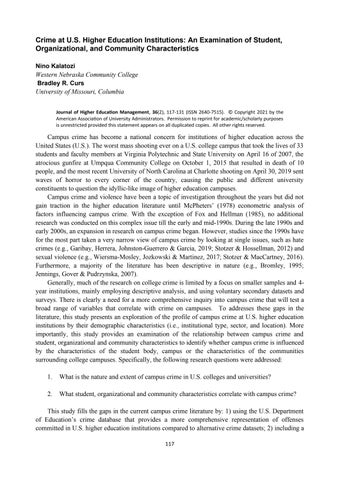Crime at U.S. Higher Education Institutions: An Examination of Student, Organizational, and Community Characteristics Nino Kalatozi
Western Nebraska Community College Bradley R. Curs
University of Missouri, Columbia Journal of Higher Education Management, 36(2), 117-131 (ISSN 2640-7515). © Copyright 2021 by the American Association of University Administrators. Permission to reprint for academic/scholarly purposes is unrestricted provided this statement appears on all duplicated copies. All other rights reserved.
Campus crime has become a national concern for institutions of higher education across the United States (U.S.). The worst mass shooting ever on a U.S. college campus that took the lives of 33 students and faculty members at Virginia Polytechnic and State University on April 16 of 2007, the atrocious gunfire at Umpqua Community College on October 1, 2015 that resulted in death of 10 people, and the most recent University of North Carolina at Charlotte shooting on April 30, 2019 sent waves of horror to every corner of the country, causing the public and different university constituents to question the idyllic-like image of higher education campuses. Campus crime and violence have been a topic of investigation throughout the years but did not gain traction in the higher education literature until McPheters’ (1978) econometric analysis of factors influencing campus crime. With the exception of Fox and Hellman (1985), no additional research was conducted on this complex issue till the early and mid-1990s. During the late 1990s and early 2000s, an expansion in research on campus crime began. However, studies since the 1990s have for the most part taken a very narrow view of campus crime by looking at single issues, such as hate crimes (e.g., Garibay, Herrera, Johnston-Guerrero & Garcia, 2019; Stotzer & Hossellman, 2012) and sexual violence (e.g., Wiersma-Mosley, Jozkowski & Martinez, 2017; Stotzer & MacCartney, 2016). Furthermore, a majority of the literature has been descriptive in nature (e.g., Bromley, 1995; Jennings, Gover & Pudrzynska, 2007). Generally, much of the research on college crime is limited by a focus on smaller samples and 4year institutions, mainly employing descriptive analysis, and using voluntary secondary datasets and surveys. There is clearly a need for a more comprehensive inquiry into campus crime that will test a broad range of variables that correlate with crime on campuses. To addresses these gaps in the literature, this study presents an exploration of the profile of campus crime at U.S. higher education institutions by their demographic characteristics (i.e., institutional type, sector, and location). More importantly, this study provides an examination of the relationship between campus crime and student, organizational and community characteristics to identify whether campus crime is influenced by the characteristics of the student body, campus or the characteristics of the communities surrounding college campuses. Specifically, the following research questions were addressed: 1.
What is the nature and extent of campus crime in U.S. colleges and universities?
2.
What student, organizational and community characteristics correlate with campus crime?
This study fills the gaps in the current campus crime literature by: 1) using the U.S. Department of Education’s crime database that provides a more comprehensive representation of offenses committed in U.S. higher education institutions compared to alternative crime datasets; 2) including a 117
